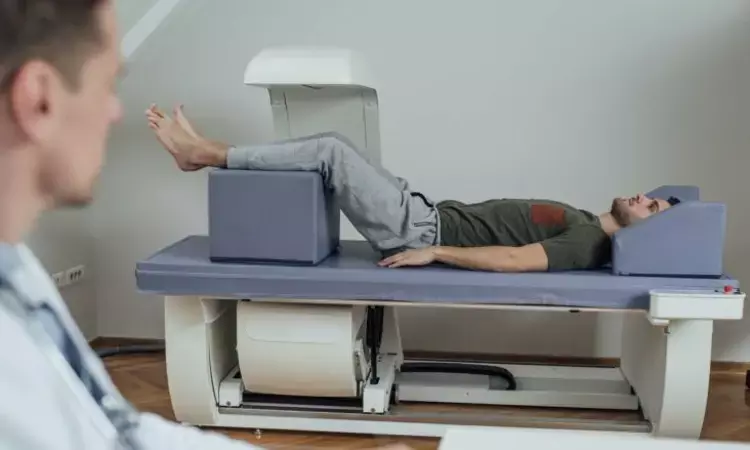- Home
- Medical news & Guidelines
- Anesthesiology
- Cardiology and CTVS
- Critical Care
- Dentistry
- Dermatology
- Diabetes and Endocrinology
- ENT
- Gastroenterology
- Medicine
- Nephrology
- Neurology
- Obstretics-Gynaecology
- Oncology
- Ophthalmology
- Orthopaedics
- Pediatrics-Neonatology
- Psychiatry
- Pulmonology
- Radiology
- Surgery
- Urology
- Laboratory Medicine
- Diet
- Nursing
- Paramedical
- Physiotherapy
- Health news
- Fact Check
- Bone Health Fact Check
- Brain Health Fact Check
- Cancer Related Fact Check
- Child Care Fact Check
- Dental and oral health fact check
- Diabetes and metabolic health fact check
- Diet and Nutrition Fact Check
- Eye and ENT Care Fact Check
- Fitness fact check
- Gut health fact check
- Heart health fact check
- Kidney health fact check
- Medical education fact check
- Men's health fact check
- Respiratory fact check
- Skin and hair care fact check
- Vaccine and Immunization fact check
- Women's health fact check
- AYUSH
- State News
- Andaman and Nicobar Islands
- Andhra Pradesh
- Arunachal Pradesh
- Assam
- Bihar
- Chandigarh
- Chattisgarh
- Dadra and Nagar Haveli
- Daman and Diu
- Delhi
- Goa
- Gujarat
- Haryana
- Himachal Pradesh
- Jammu & Kashmir
- Jharkhand
- Karnataka
- Kerala
- Ladakh
- Lakshadweep
- Madhya Pradesh
- Maharashtra
- Manipur
- Meghalaya
- Mizoram
- Nagaland
- Odisha
- Puducherry
- Punjab
- Rajasthan
- Sikkim
- Tamil Nadu
- Telangana
- Tripura
- Uttar Pradesh
- Uttrakhand
- West Bengal
- Medical Education
- Industry
DXA Scan Can Prevent Major Fractures among Prostate Cancer patients on ADT

Prostate cancer accounts for 26% of all new cancers in men. Androgen deprivation therapy (ADT) is the mainstay for the treatment of locally advanced high-risk localized or metastatic prostate cancer.Bone health screening is recommended for patients with prostate cancer who are initiating treatment with ADT.
In a recent study, researchers reiterated the clinical importance of performing dual-energy x-ray absorptiometry (DXA) screening for major fracture prevention among older men with prostate cancer. The study findings were published in the JAMA Network Open on April 01, 2022.
Several systematic reviews from the early 2000s as well as more recent guidelines advocate screening for osteoporosis using DXA. However, bone mineral density screening rates in the US and their association with fracture prevention are unknown. Therefore, Dr Maria E. Suarez-Almazor and her team conducted a study to assess dual-energy x-ray absorptiometry (DXA) screening rates and their association with fracture rates among older men with prostate cancer-initiating treatment with androgen deprivation therapy.
In a retrospective nationwide population-based cohort study, the researchers used data from the Surveillance, Epidemiology, and End Results database and the Texas Cancer Registry linked with Medicare claims. They included data of 54 953 men with prostate cancer who initiated treatment with ADT. They examined DXA screening within 12 months before and 6 months after the first ADT claim. The major outcome assessed was the frequencies of DXA screening and fracture (any fracture and major osteoporotic fracture) and overall survival. They used a multivariable Cox proportional hazards model with propensity score adjustment to evaluate the association between DXA screening and fracture.
Key findings of the study;
- Among 54 953 men, the researchers observed that only 4362 men (7.9%) received DXA screening.
- They noted that the DXA screening rate increased from 6.8% in 2005 to 8.4% in 2015.
- They found that lower screening rates were associated with being single (odds ratio [OR], 0.89) and non-Hispanic Black (OR, 0.80), living in small urban areas (OR, 0.77) and areas with lower educational levels (OR, 0.75), and receiving nonsteroidal androgens (OR, 0.57).
- They noted that overall, 9365 patients (17.5%) developed fractures after initial receipt of ADT with a median time to first fracture as 31 months.
- Upon multivariable model with propensity score adjustment, they found that DXA screening was not associated with fracture risk at any site (hazard ratio [HR], 0.96) among men without previous fractures before receipt of ADT.
- However, they noted that previous DXA screening was associated with a decreased risk of major fractures (HR, 0.91) after propensity score adjustment.
The authors concluded, "In this study, low DXA screening rates were observed among older men with localized or regional prostate cancer after initiation of treatment with ADT. Despite low rates of screening, evaluation of bone mineral density with a DXA scan was associated with lower risk of major fractures. These findings suggest that DXA screening is important for the prevention of major fractures among older men with prostate cancer and that implementation strategies are needed to adopt bone health screening guidelines in clinical practice."
For further information:
DOI: 10.1001/jamanetworkopen.2022.5432
Keywords: Dual-energy x-ray absorptiometry, DXA screening, Prostate cancer, Androgen deprivation therapy, Fracture Risk, Fracture prevention, older men, osteoporotic fracture, Bone health, JAMA Network Open.
Medical Dialogues Bureau consists of a team of passionate medical/scientific writers, led by doctors and healthcare researchers. Our team efforts to bring you updated and timely news about the important happenings of the medical and healthcare sector. Our editorial team can be reached at editorial@medicaldialogues.in.
Dr Kamal Kant Kohli-MBBS, DTCD- a chest specialist with more than 30 years of practice and a flair for writing clinical articles, Dr Kamal Kant Kohli joined Medical Dialogues as a Chief Editor of Medical News. Besides writing articles, as an editor, he proofreads and verifies all the medical content published on Medical Dialogues including those coming from journals, studies,medical conferences,guidelines etc. Email: drkohli@medicaldialogues.in. Contact no. 011-43720751


